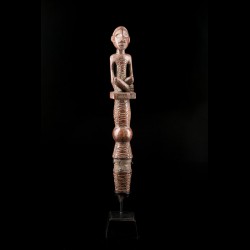














Among the Bembe, the plastic arts give pride of place to the ancestors, the spirits and the forces of nature. Bembe sculptural art, unlike that of other black African populations in the fields of religion, magic, politics, therapy, etc., is therefore confined to the anthropomorphic figure sculpted in wood, used not only in the making of magical or religious supports, but also in the creation of certain accessories such as this fly-catcher presented in a kneeling position and with body markings in the form of tattoos with a keloidal appearance. This mastered sculpture is sold on its customised base.
A wooden fly whisk of the Bembe people with a honey coloured patina to the surface. To the top of the fly whisk is a seated figure of a male displaying a regal dignity in the pose and carving the head has a small cap of hair to the back and the face has a prominent nose with flared nostrils and large, almond shaped eyes that are recessed for separate inlays. The mouth is slightly open and has fleshy lips, and to the chin is a short beard. The figure is seated cross-legged and has a panel of geometric decoration to the chest representing scarification marks. The body of the handle has been carved into a spindle form and is profusely decorated with engraved lines.
The fly whisk is known as a Nsesa to the Bembe people and is one of the distinguishing pieces of regalia associated with a chief. The figure to the top of this fly whisk is the image of an ancestor, through which the chief gains his power and knowledge. As well as having a practical function of keeping flies away, they are also used to confer blessings on people and to ritually brush away evil spirits.
Data sheet

Among the Bembe, the plastic arts give pride of place to the ancestors, the spirits and the forces of nature. Bembe sculptural art, unlike that of other black African populations in the fields of religion, magic, politics, therapy, etc., is therefore confined to the anthropomorphic figure sculpted in wood, used not only in the making of magical or religious supports, but also in the creation of certain accessories such as this fly-catcher presented in a kneeling position and with body markings in the form of tattoos with a keloidal appearance. This mastered sculpture is sold on its customised base.
A wooden fly whisk of the Bembe people with a honey coloured patina to the surface. To the top of the fly whisk is a seated figure of a male displaying a regal dignity in the pose and carving the head has a small cap of hair to the back and the face has a prominent nose with flared nostrils and large, almond shaped eyes that are recessed for separate inlays. The mouth is slightly open and has fleshy lips, and to the chin is a short beard. The figure is seated cross-legged and has a panel of geometric decoration to the chest representing scarification marks. The body of the handle has been carved into a spindle form and is profusely decorated with engraved lines.
The fly whisk is known as a Nsesa to the Bembe people and is one of the distinguishing pieces of regalia associated with a chief. The figure to the top of this fly whisk is the image of an ancestor, through which the chief gains his power and knowledge. As well as having a practical function of keeping flies away, they are also used to confer blessings on people and to ritually brush away evil spirits.